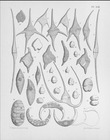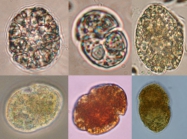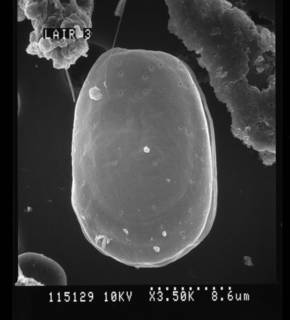
| Introduction | | Search taxa | | Taxon tree | | Taxon match | | Checklist | | Literature | | Stats | | Photogallery | | OBIS Vocab | | Log in |
CaRMS taxon detailsGymnodinium F.Stein, 1878
marine, brackish, fresh, terrestrial
Not documented
LSID urn:lsid:algaebase.org:taxname:6790
LSID urn:lsid:algaebase.org:taxname:6790 [details]
Guiry, M.D. & Guiry, G.M. (2024). AlgaeBase. World-wide electronic publication, National University of Ireland, Galway (taxonomic information republished from AlgaeBase with permission of M.D. Guiry). Gymnodinium F.Stein, 1878. Accessed through: Nozères, C., Kennedy, M.K. (Eds.) (2024) Canadian Register of Marine Species at: https://www.marinespecies.org/Carms/aphia.php?p=taxdetails&id=109475 on 2024-04-19
Nozères, C., Kennedy, M.K. (Eds.) (2024). Canadian Register of Marine Species. Gymnodinium F.Stein, 1878. Accessed at: https://www.marinespecies.org/carms/aphia.php?p=taxdetails&id=109475 on 2024-04-19
Date action by 2004-12-21 15:54:05Z created db_admin 2006-07-12 06:39:56Z changed Camba Reu, Cibran
basis of record
Gómez, F. (2005). A list of free-living dinoflagellate species in the world's oceans. <em>Acta Bot. Croat.</em> 64(1): 129-212. [details]
additional source Kofoid, C.A.; Swezy, O. (1921). The free-living unarmored Dinoflagellata. <em>Memoirs of the University of California.</em> 5: i-viii, 1-562., available online at https://www.biodiversitylibrary.org/page/20306447 [details] additional source Steidinger, K.A.; Tangen, K. (1997). Dinoflagellates. pp. 387-584. In: C.R. Tomas (ed.) (1997). Identifying Marine Phytoplankton. Academic Press: San Diego, CA [etc.] (USA). ISBN 0-12-693018-X. XV, 858 pp., available online at http://www.sciencedirect.com/science/article/pii/B9780126930184500057 [details] additional source Guiry, M.D. & Guiry, G.M. (2023). AlgaeBase. <em>World-wide electronic publication, National University of Ireland, Galway.</em> searched on YYYY-MM-DD., available online at http://www.algaebase.org [details] additional source Integrated Taxonomic Information System (ITIS). , available online at http://www.itis.gov [details] additional source Hayward, P. J.; Nelson-Smith, A.; Shields, C. (1996). Collins pocket guide: sea shore of Britain and Europe. <em>Collins pocket guides. Harper-Collins Publishers: London, UK. ISBN 0-00-219955-6.</em> 352 pp. (look up in IMIS) [details] additional source Parker, S.P. (Ed.) (1982). Synopsis and classification of living organisms. McGraw Hill Book Company: New York, NY (USA). ISBN 0-07-079031-0. 1166, 1232 pp. (look up in IMIS) [details]  Present Present  Inaccurate Inaccurate  Introduced: alien Introduced: alien  Containing type locality Containing type locality
From editor or global species database
LSID urn:lsid:algaebase.org:taxname:6790 [details]From other sources
Classification This genus was originally placed under the family Gymnodiniidae as proposed by Hayward and Ryland (1990). [details]Diet general for group: both heterotrophic (eat other organisms) and autotrophic (photosynthetic) [details] Ecology Blooms of this genus were recorded as early as 1937 in the Oslo Fjord (Braarud, 1945) an have occured more recently as G. sanguinum with concentrations up to 35 106 ind/l. [details] Habitat pelagic [details] Importance General: known for producing dangerous toxins, particularly when in large numbers, called "red tides" because the cells are so abundant they make water change color. Also they can produce non-fatal or fatal amounts of toxins in predators (particularly shellfish) that may be eaten by humans. [details] Predators marine microorganisms and animal larvae [details] Reproduction general for group: both sexual and asexual [details]
|





